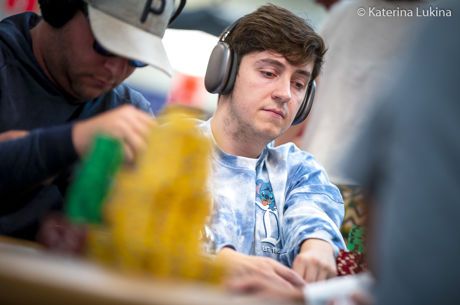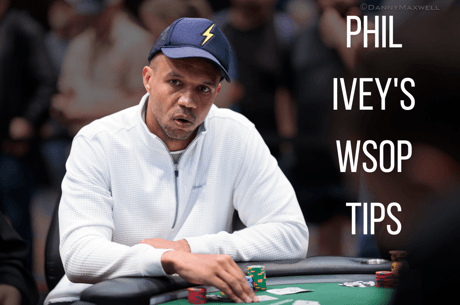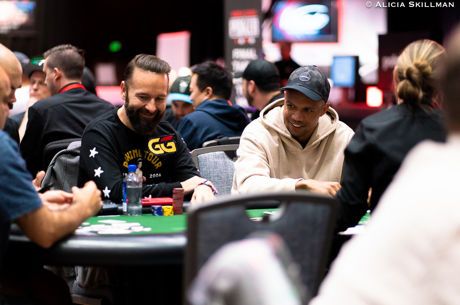Revealing the Hand: 5 Common Tells You Can Spot at the WSOP
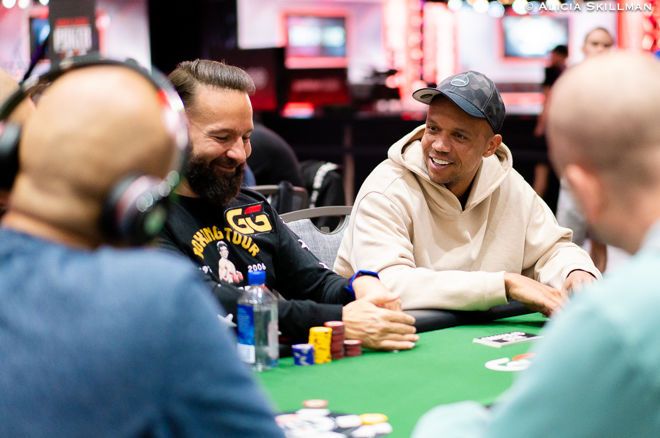
Table Of Contents
The World Series of Poker (WSOP) is the crown jewel of the poker calendar, where players from all walks of life gather to test their mettle and chase glory.
And with poker being a game of skill, strategy, and reading your opponents, one crucial aspect of the game is spotting tells.
These could be subtle physical or behavioral cues that can provide useful information about an opponent's hand strength. In this article, we explore five common tells you can spot at the WSOP, giving you an edge in the quest for a gold bracelet.
Timing Tells
Timing tells can reveal valuable information about an opponent's thought process. Certain players may act quickly when they have a strong hand to portray confidence, while a lengthy deliberation could suggest weakness or uncertainty. Observing a player's consistent patterns of quick or slow decision-making can help you decipher their hand strength and potentially exploit their tendencies.
Body Language and Gestures
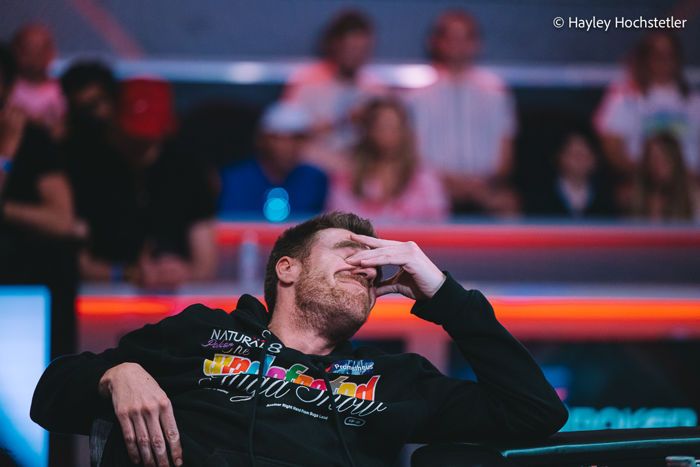
Physical tells, such as body language and gestures, can be crucial for figuring out how strong or weak someone's holdings are.
Be sure to focus on an opponent's facial expressions, posture, and hand movements during key moments in the hand.
For instance, a player who suddenly becomes still and tense may have a strong hand, while fidgeting or nervous tics might indicate weakness or anxiety. It's important to note that experienced players may deliberately display false tells to mislead their opponents, so that's always something to keep in mind as well.
2023 World Series of Poker Hub
Bookmark this page! All you need to know about the 2023 WSOP is here.
Bet Sizing
One of the most telling cues at the WSOP is a player's bet sizing. Generally, when players exhibit consistent patterns in their bets, it can provide hints about their hand strength.
For example, a small bet might indicate weakness or a marginal hand, while a large, confident bet could signify a strong hand. However, it's important to consider each player's individual style and adjust your analysis accordingly.
This is one of the main tells you should be looking out for when playing against weaker opponents at the WSOP.
Eye Contact (or Lack Thereof)
The eyes are often considered the windows to the soul, and they can reveal a lot at the poker table.
Maintaining eye contact or deliberately avoiding it can be a significant tell. A player who confidently maintains eye contact will likely possess a strong hand, whereas avoiding eye contact might indicate that someone is bluffing.
However, it's essential to exercise caution, as some players are adept at disguising their true intentions through deliberate eye contact manipulation.
Verbal Cues and Speech Patterns
Verbal cues and speech patterns can provide valuable insights into an opponent's mindset. Pay attention to any verbal statements, such as sighs, hesitations, or changes in tone. These cues might indicate confidence, frustration, or deception.
Moreover, listen for inconsistencies in players' statements, as they may inadvertently reveal their true hand strength or intentions. Skilled players can use their words to mislead, so it's crucial to analyze speech patterns in addition to other tells.
Conclusion
You need to be an observant person to pick up on poker tells. Furthermore, you need to use poker tells as part of your information gathering and not as the only component of it. Pay particular attention to the hands your opponents showdown after acting a certain way. What did they do before and during a hand where they showed a strong holding? What about when they were caught bluffing? Build a mental database of your opponent's tendencies.
Also, be aware some players are incredibly clever and will act weak when strong and vice-versa.
Finally, do not only observe these tells in your opponents but be aware you may be giving off similar tells. Keep your actions uniform regardless of what you plan to do in the hand, and prevent opponents from picking up information about you and your holdings.
In this Series
- 1 Here's the Full Schedule for 2023 World Series of Poker (WSOP); Win Main Event for Life!
- 2 Reigning Main Event Champion Espen Jorstad Eyes "Crazy Summer"; Plans to Play Full 2023 WSOP Schedule
- 3 6 Las Vegas Facts That Sound False But Are Actually True!
- 4 How to Decide Which WSOP Tournament(s) to Play
- 5 Registration for 2023 World Series of Poker (WSOP) is Now Open
- 6 How to Stay Healthy in Las Vegas During the WSOP
- 7 WSOP Main Event Champions 2015-17: McKeehen, Nguyen, Blumstein
- 8 PokerGO's 2023 WSOP Live-stream Schedule Covers Biggest Events and More
- 9 2023 Main Event Maynia Could Be Your Best Chance of Playing at the WSOP
- 10 A Look at the 2023 WSOP Online Bracelet Schedule – How to Deposit
- 11 Five Reasons Winning Poker Players Lose Money at the WSOP
- 12 Five Questions to Ask Yourself at Your First WSOP
- 13 Interview: Vice President Jack Effel Looks Ahead to 2023 WSOP
- 14 World Series of Poker Addresses Solver Concerns, Clarifies RTA Policy
- 15 Negreanu, Deeb Again Highest Valued WSOP $25K Fantasy Draft Picks
- 16 PokerNews Staff 2023 WSOP Predictions – Will Ivey Play? Hellmuth vs. Negreanu?
- 17 Let the Games Begin: 2023 World Series of Poker Officially Underway
- 18 WNBA Champion Kelsey Plum Kicks Off WSOP Mystery Millions
- 19 5 Poker Tax Facts to Remember Heading into the 2023 WSOP
- 20 Introducing The Chad & Jesse Poker Show; Two Episodes a Week During 2023 WSOP
- 21 PokerNews Podcast: Catching Up w/ WSOP Executive Director Ty Stewart
- 22 Negreanu or Hellmuth — Who Will Have the Best 2023 WSOP?
- 23 Some of the Best Poker Players Who Haven't Won a WSOP Bracelet
- 24 Quads, Runner-Runner & Other Crazy Hands From the WSOP $25,000 High Roller
- 25 2023 WSOP Featured Females: Maria Konnikova & Kristen Foxen Making Runs
- 26 Phil Ivey, Doug Polk in Action at Epic WSOP $25k Heads-Up Tournament
- 27 Five Tournaments Fans Don't Want to Miss at the 2023 World Series of Poker
- 28 Five Reasons Winning Poker Players Lose Money at the WSOP
- 29 We Asked ChatGPT to Predict the WSOP $25K Heads Up Championship
- 30 Doug Polk Headlines the Final Four in WSOP $25K Heads Up Championship
- 31 Two $1,000,000 Prizes Pulled in WSOP Mystery Millions
- 32 Five Questions to Ask Yourself at Your First WSOP
- 33 Andrews Suffers Brutal Beat on $5K Freezeout Bubble; Hellmuth Deep in $600 Deepstack
- 34 The Two Failed Bluffs in One Week that Cost Doug Polk $700k
- 35 2023 Poker Hall of Fame Nominations Open; Rast, Scheinberg, Savage Frontrunners?
- 36 Badugi Primer - Get Ready for A Brand New WSOP Tournament
- 37 2023 Poker Hall of Fame Nominations Open; Rast, Scheinberg, Savage Frontrunners?
- 38 Estes Nabs Second WSOP MI Online Bracelet; Kershaw Victorious in First PA Event
- 39 Steve "Cuz" Buckner & Lon McEachern Recent Guests on The Chad & Jesse Poker Show
- 40 Is Today the Day Isaac Haxton Finally Wins His First WSOP Bracelet?
- 41 Hitting the Nuts: Man & Woman Discuss Infamous 2023 WSOP Low Blow
- 42 Sarah Herzali Comes Up Shy of Being First Female Bracelet Winner of 2023 WSOP
- 43 A Look Inside Phil Hellmuth's WSOP Break Room: How Does He Fit on that Couch?
- 44 Scotty Nguyen Recovering From Surgery, Will Miss First Half of WSOP
- 45 Man of the People: How Daniel Negreanu Bagged Top 4 Stack on $300 Gladiator Day 1a
- 46 PN Podcast: Poker Hall of Famer Jack McClelland Shares Stories About Doyle Brunson & Stu Ungar
- 47 Poker Player Spikes Quads on River to Escape WSOP $50K Bubble
- 48 2023 WSOP Hands of the Week: Polk's Miracle Two Outer; Accidental Exposure Saves Tull from Bubble
- 49 Phil Galfond Offers Poker Hall of Fame Pick; Says Two Should Be Inducted Per Year
- 50 Poker Boom 2.0? WSOP Attendance Crushing Last Year's Turnout
- 51 Stanley Cup Champs! Vegas Poker Community Reacts to Golden Knights' Win
- 52 Erik Seidel on Verge of Joining Poker's Most Exclusive Club: 10 WSOP Bracelets
- 53 WSOP Player of the Week: Josh Arieh Makes Poker Hall of Fame Case
- 54 Next Fedor? This German 22-Year-Old is Taking the 2023 WSOP by Sturm
- 55 Daniel Negreanu Quietly Having Success in Large Field Events at 2023 WSOP
- 56 Mike "BrockLesnar" Holtz Running Away with WSOP.com Player of the Year
- 57 Jennifer Harman Remembers Doyle: "He Was Like a Marshmallow Puppy Dog to Me"
- 58 Aces, Kings, Kings, and Queens - You Won't Believe this Epic 2023 WSOP Hand
- 59 Jason Koon's Stack Pulled from WSOP $250K Super High Roller as Wife Enters Labor
- 60 Meet The WSOP App Thrill Team
- 61 TripAdvisor’s Top 10 Things To Do In Las Vegas During The 2023 WSOP
- 62 Phil Ivey Bubbles the 2023 WSOP $250,000 Super High Roller
- 63 Unknown Poker Player in Town for Father's Day Randomly Enters WSOP $250K
- 64 2023 WSOP Hands of the Week: Negreanu Knows All The Angles, a Quads Counterfeit
- 65 Jungleman Attempts to Terminate PPC Field for 3rd Straight Year; Moneymaker Jumps In
- 66 Ivey Puts Life on Line in Level 5 of $50,000 PPC in Massive PLO Pot – Did He Win?
- 67 "Bucket List Event": Moneymaker Makes WSOP $50k Poker Players Championship Debut
- 68 Kabrhel Denies Cheating Allegations, Threatens to Sue Robl
- 69 King's Resort Has Big WSOP Plans For The Rest Of 2023
- 70 No 11th Bracelet As Johnny Chan Falls in 14th in WSOP $1,500 Big O
- 71 Win Your Way Into 2023 WSOP Main Event with 112 Seat Sprint on WSOP.com
- 72 The Muck: Should Poker Community Ban Martin Kabrhel?
- 73 Phil Ivey Closing in on 11th Bracelet; Rast Playing for the Poker Hall of Fame?
- 74 Horseshoe to Host Doyle Brunson Celebration of Life Memorial July 2
- 75 Familiar Faces Among 2023 Poker Hall of Fame Nominations
- 76 Negreanu Proposes Changes to the Poker Hall of Fame Induction Process
- 77 No-Limit Hold'em Crushers Driving WSOP $25K Fantasy Draft Top Team
- 78 2023 WSOP Featured Females: Women in Full Force in Tag Team Event
- 79 World Series of Poker 2024: Read Phil Ivey's Top WSOP Tips
- 80 Poker Hall of Famer Billy Baxter Eyes Up First Bracelet in 21 Years
- 81 Revealing the Hand: 5 Common Tells You Can Spot at the WSOP
- 82 2023 WSOP Hands of the Week: Royal Flush Over Quads; KK < KK & 4-of-a-Kind for Seidel
- 83 "Barstool Nate" Shares His Wild Adventure Getting to the 2023 WSOP One Month Late
- 84 Remembering Doyle Brunson's Final WSOP Cash in 2018, a Near Bracelet Win
- 85 2023 WSOP Featured Females: Who Will Win the Largest Ladies Event In Poker History?
- 86 Upcoming WSOP Circuit Schedule is Out; $1 Million Freeroll Returns
- 87 PN Podcast: GGPoker Ambassador Daniel Negreanu Talks 2023 WSOP & Poker Hall of Fame
- 88 The Smoking Petition: How Tom McEvoy Helped the WSOP Become Smoke Free
- 89 2023 WSOP Hands of the Week: Poker Player Learns Lesson for Premature Celebration
- 90 Hellmuth, Negreanu Pay Tribute to Doyle Brunson at 2023 WSOP
- 91 Silicon Valley's Chamath Palihapitiya Returns to the WSOP After a Decade
- 92 Admitted Poker Cheater Ali Imsirovic Enters WSOP $1,500 Shootout Event
- 93 Six-Time Bracelet Winner Brian Rast Voted Into Poker Hall of Fame
- 94 Lexy Gavin-Mather Is One of the 2023 WSOP's Most Prolific Vloggers
- 95 PN Podcast: Final Show from the 2023 WSOP w/ Guests Brian Rast & Phil Hellmuth
- 96 How Much Money Players at 2023 WSOP Main Event Final Table Really Made
- 97 Mike Holtz Nabs WSOP Cashes Record While Ian Matakis is POY
- 98 The Complete Overview of the 2023 NV/NJ WSOP Online Bracelet Events
- 99 Daniel Weinman Wins Record-Breaking 2023 WSOP Main Event for $12,100,000
- 100 Nicolai Morris & Elias Garney Win Final WSOP Online Bracelets in Michigan & Pennsylvania


